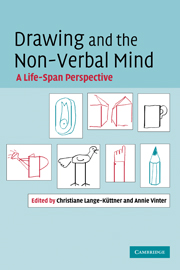Book contents
- Frontmatter
- Contents
- Contributors
- 1 Contemporary enquiries into a long-standing domain: Drawing research
- Part I Self, symbols and intention
- Part 2 Syntax, space systems and projection
- Part III Aging, blindness and autism
- 13 Benefits of graphic design expertise in old age: compensatory effects of a graphical lexicon?
- 14 Drawing as a ‘window’ on deteriorating conceptual knowledge in neurodegenerative disease
- 15 Drawings by a blind adult: orthogonals, parallels and convergence in two directions without T-junctions
- 16 Differences between individuals with and without autism in copying tasks: how knowledge interferes when drawing perspective
- Index
- References
16 - Differences between individuals with and without autism in copying tasks: how knowledge interferes when drawing perspective
Published online by Cambridge University Press: 22 September 2009
- Frontmatter
- Contents
- Contributors
- 1 Contemporary enquiries into a long-standing domain: Drawing research
- Part I Self, symbols and intention
- Part 2 Syntax, space systems and projection
- Part III Aging, blindness and autism
- 13 Benefits of graphic design expertise in old age: compensatory effects of a graphical lexicon?
- 14 Drawing as a ‘window’ on deteriorating conceptual knowledge in neurodegenerative disease
- 15 Drawings by a blind adult: orthogonals, parallels and convergence in two directions without T-junctions
- 16 Differences between individuals with and without autism in copying tasks: how knowledge interferes when drawing perspective
- Index
- References
Summary
Sheppard, Mitchell and Ropar investigate whether individuals with autism are less likely than control participants to use object-specific drawing schemata which do not depict the model they actually see. Self-taught savant skills are much more frequent in autistic populations, and it is assumed that these may be responsible for a less conceptual approach which allows lower-level perceptual processing to prevail. However, because the empirical results from previous research did not prove to be conclusive, Sheppard, Mitchell and Ropar in several studies used tasks where in one condition a purely geometrical form was presented, while in the other condition features were added to convey the impression of a more meaningful object from everyday life. In children and adults without autism, meaningfulness could lower or enhance the level of drawing, depending on the kind of object, while spatial complexity appeared always to make drawing more difficult. Individuals with autism, however, were better able either to overcome or to ignore conceptual object knowledge, in particular when recreating a line drawing. It is concluded that this result reflects a special ability for literal understanding in autism.
a great deal of research on drawing has focused on the effects of conceptual knowledge on performance. Generally, the bulk of findings suggest that prior knowledge about the subject matter interferes with accurate depiction. It seems that participants are liable to rely upon this instead of the viewpoint-specific information projected onto the retina. In other words, people sometimes draw what they know rather than what they see.
- Type
- Chapter
- Information
- Drawing and the Non-Verbal MindA Life-Span Perspective, pp. 325 - 343Publisher: Cambridge University PressPrint publication year: 2008
References
- 5
- Cited by



